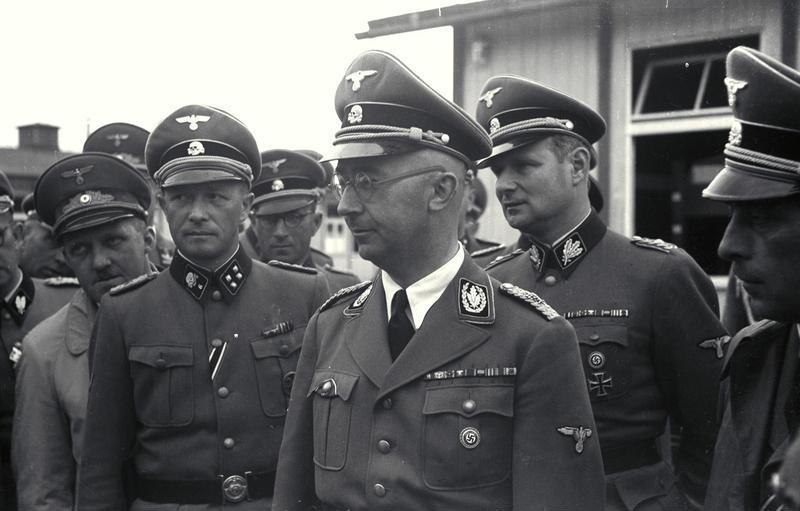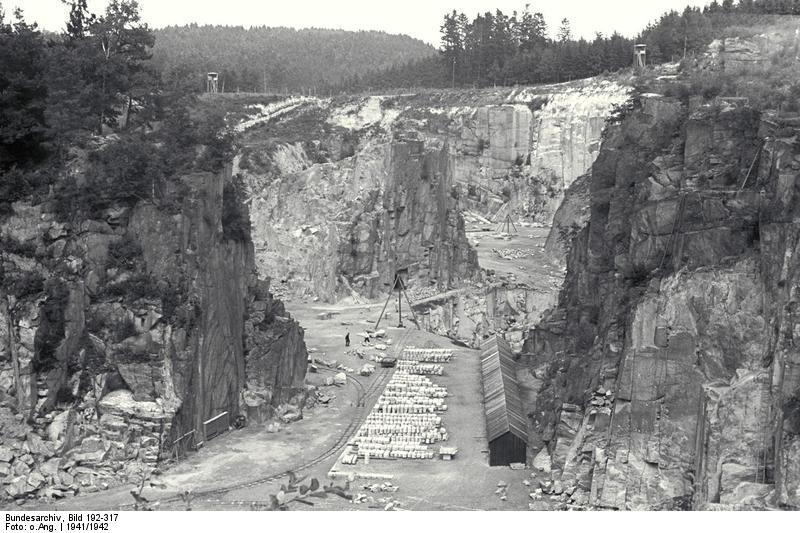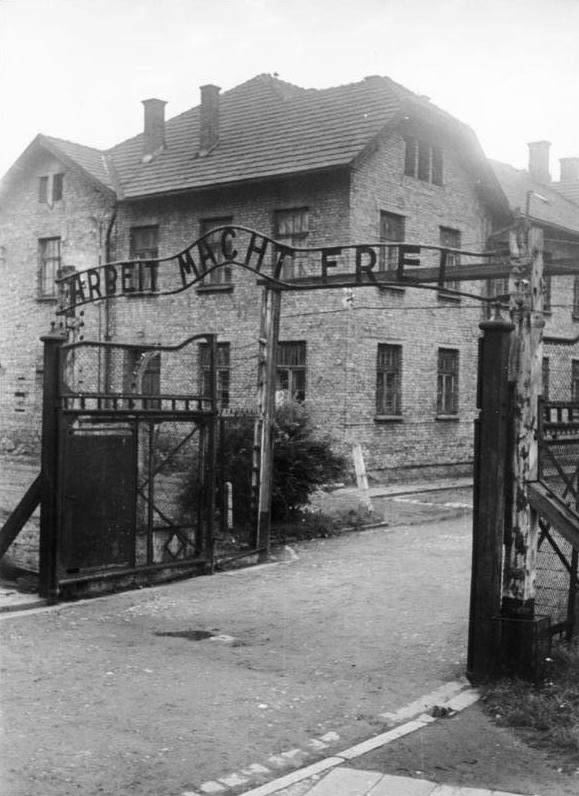|
Franz Ziereis
Franz Xaver Ziereis (13 August 1905 – 24 May 1945) was the commandant of the Mauthausen concentration camp from 1939 until the camp was liberated by the American forces in 1945. Early life and SS career Ziereis was born on 13 August 1905 in Munich, Kingdom of Bavaria, German Empire (now in Bavaria, Germany), where he spent 8 years in elementary school and then began as an apprentice and messenger boy in a department store. In the evenings he studied commerce. In 1922 he went to work as a labourer in a carpentry shop. Ziereis joined Germany's Reichswehr (army) on 1 April 1924, for a period of 12 years. He was discharged with the rank of sergeant in 1936 and joined the SS on September 30 of the same year. He attained the rank of SS-Obersturmführer and was assigned as a training instructor to the SS-Totenkopfverbände. In 1937 he was given command of a Totenkopfverbände unit and later became a training instructor. Concentration camp commandant Zeireis replaced Albert Sau ... [...More Info...] [...Related Items...] OR: [Wikipedia] [Google] [Baidu] |
Munich
Munich ( ; german: München ; bar, Minga ) is the capital and most populous city of the German state of Bavaria. With a population of 1,558,395 inhabitants as of 31 July 2020, it is the third-largest city in Germany, after Berlin and Hamburg, and thus the largest which does not constitute its own state, as well as the 11th-largest city in the European Union. The city's metropolitan region is home to 6 million people. Straddling the banks of the River Isar (a tributary of the Danube) north of the Bavarian Alps, Munich is the seat of the Bavarian administrative region of Upper Bavaria, while being the most densely populated municipality in Germany (4,500 people per km2). Munich is the second-largest city in the Bavarian dialect area, after the Austrian capital of Vienna. The city was first mentioned in 1158. Catholic Munich strongly resisted the Reformation and was a political point of divergence during the resulting Thirty Years' War, but remained physicall ... [...More Info...] [...Related Items...] OR: [Wikipedia] [Google] [Baidu] |
Albert Sauer
Albert Sauer (17 August 1898, Misdroy – 3 May 1945, Falkensee) was a German commandant of Mauthausen-Gusen concentration camp. Life Sauer, a carpenter by trade, became a member of the NSDAP (Nazi Party) and the SS in 1931. After a period of unemployment, he became a full-time SS employee.Wolfgang Benz, Barbara Distel (ed.). ''Der Ort des Terrors: Geschichte der nationalsozialistischen Konzentrationslager, Flossenbürg, Mauthausen, Ravensbrück'', Vol. 4, Munich 2006 p. 295/ref> A protégé of the Inspector of Concentration Camps Theodor Eicke, Sauer was assigned to the SS guard unit (''Wachtruppe'') of Oranienburg concentration camp in April 1935. From 1 April 1936, he was commandant of Bad Sulza concentration camp. Between 1 August 1937 and mid-1938, Sauer was second '' Schutzhaftlagerführer'' in Sachsenhausen concentration camp and thus belonged to '' "Wachtruppe Brandenburg"''. In the period between 1 August 1938 and 1 April 1939, he officially acted as commandant of ... [...More Info...] [...Related Items...] OR: [Wikipedia] [Google] [Baidu] |
Mauthausen Concentration Camp Personnel
Mauthausen was a Nazi concentration camp on a hill above the market town of Mauthausen (roughly east of Linz), Upper Austria. It was the main camp of a group with nearly 100 further subcamps located throughout Austria and southern Germany. The three Gusen concentration camps in and around the village of St Georgen/Gusen, just a few kilometres from Mauthausen, held a significant proportion of prisoners within the camp complex, at times exceeding the number of prisoners at the Mauthausen main camp. The Mauthausen main camp operated from 8 August 1938, several months after the German annexation of Austria, to 5 May 1945, when it was liberated by the United States Army. Starting with the camp at Mauthausen, the number of subcamps expanded over time. In January 1945, the camps contained roughly 85,000 inmates. As at other Nazi concentration camps, the inmates at Mauthausen and its subcamps were forced to work as slave labour, under conditions that caused many deaths. Mauthau ... [...More Info...] [...Related Items...] OR: [Wikipedia] [Google] [Baidu] |
1945 Deaths
1945 marked the end of World War II and the fall of Nazi Germany and the Empire of Japan. It is also the only year in which nuclear weapons have been used in combat. Events Below, the events of World War II have the "WWII" prefix. January * January 1 – WWII: ** Germany begins Operation Bodenplatte, an attempt by the ''Luftwaffe'' to cripple Allied air forces in the Low Countries. ** Chenogne massacre: German prisoners are allegedly killed by American forces near the village of Chenogne, Belgium. * January 6 – WWII: A German offensive recaptures Esztergom, Hungary from the Russians. * January 12 – WWII: The Soviet Union begins the Vistula–Oder Offensive in Eastern Europe, against the German Army. * January 13 – WWII: The Soviet Union begins the East Prussian Offensive, to eliminate German forces in East Prussia. * January 16 – WWII: Adolf Hitler takes residence in the ''Führerbunker'' in Berlin. * January 17 ** WWII: The Soviet Union occupies Warsaw, Polan ... [...More Info...] [...Related Items...] OR: [Wikipedia] [Google] [Baidu] |
1905 Births
Nineteen or 19 may refer to: * 19 (number), the natural number following 18 and preceding 20 * one of the years 19 BC, AD 19, 1919, 2019 Films * ''19'' (film), a 2001 Japanese film * ''Nineteen'' (film), a 1987 science fiction film Music * 19 (band), a Japanese pop music duo Albums * ''19'' (Adele album), 2008 * ''19'', a 2003 album by Alsou * ''19'', a 2006 album by Evan Yo * ''19'', a 2018 album by MHD * ''19'', one half of the double album '' 63/19'' by Kool A.D. * '' Number Nineteen'', a 1971 album by American jazz pianist Mal Waldron * ''XIX'' (EP), a 2019 EP by 1the9 Songs * "19" (song), a 1985 song by British musician Paul Hardcastle. * "Nineteen", a song by Bad4Good from the 1992 album ''Refugee'' * "Nineteen", a song by Karma to Burn from the 2001 album ''Almost Heathen''. * "Nineteen" (song), a 2007 song by American singer Billy Ray Cyrus. * "Nineteen", a song by Tegan and Sara from the 2007 album '' The Con''. * "XIX" (song), a 2014 song by S ... [...More Info...] [...Related Items...] OR: [Wikipedia] [Google] [Baidu] |
Hans Maršálek
Hans Maršálek (19 July 1914 – 9 December 2011) was an Austrian typesetter, political activist, detective, and historian. A devout socialist and active in the resistance, he was arrested by the Nazis and imprisoned in the Mauthausen concentration camp. After the war, he joined the Austrian political police and was instrumental in tracking down and convicting numerous Nazi criminals. He also became the main chronicler of the camp's history, helped establish the Mauthausen Memorial Museum, and published several books. Early life Maršálek was born on 19 July 1914 in Vienna to an ethnically Czech family. His father was a builder, his mother worked as a maid. The family lived in Hernals, a working-class district, in humble circumstances. Both parents were members of the Social Democratic Party; Maršálek's father eventually was elected to the Hernals district council on a Social Democratic ticket. Maršálek was educated in Vienna's Czech School. In his teens, he apprenticed ... [...More Info...] [...Related Items...] OR: [Wikipedia] [Google] [Baidu] |
Gusen Concentration Camp
Gusen was a subcamp of Mauthausen concentration camp operated by the SS () between the villages of Sankt Georgen an der Gusen and Langestein in the Reichsgau Ostmark (currently Perg District, Upper Austria). Primarily populated by Polish prisoners, there were also large numbers of Spanish Republicans, Soviet citizens, and Italians. Initially, prisoners worked in nearby quarries, producing granite which was sold by the SS company DEST. Conditions were worse than at the Mauthausen main camp due to the camp's purpose of extermination through labor of real and perceived enemies of Nazi Germany. The life expectancy of prisoners was as short as six months, and at least 35,000 people died there from forced labor, starvation, and mass executions. From 1943, the camp was an important center of armaments production for Messerschmitt and Steyr-Daimler-Puch. In order to expand armaments production, the camp was redesignated Gusen I, and additional camps, Gusen II and Gusen III, were b ... [...More Info...] [...Related Items...] OR: [Wikipedia] [Google] [Baidu] |
Standartenführer
__NOTOC__ ''Standartenführer'' (short: ''Staf'', , ) was a Nazi Party (NSDAP) paramilitary rank that was used in several NSDAP organizations, such as the SA, SS, NSKK and the NSFK. First founded as a title in 1925, in 1928 it became one of the first commissioned NSDAP ranks and was bestowed upon those SA and SS officers who commanded a unit known as a ''Standarte'' (plural ''Standarten''), a unit equivalent to an army battalion and comprising 300–500 personnel. In 1929 the rank of ''Standartenführer'' was divided into two separate ranks known as ''Standartenführer'' (I) and ''Standartenführer'' (II). This concept was abandoned in 1930 when both the SA and SS expanded their rank systems to allow for more officer positions and thus the need for only a single ''Standartenführer'' rank. In 1933, when Adolf Hitler came to national power in Germany, the rank of ''Standartenführer'' had been established as the highest field officer rank, lower than that of ''Oberführer'' o ... [...More Info...] [...Related Items...] OR: [Wikipedia] [Google] [Baidu] |
Sturmbannführer
__NOTOC__ ''Sturmbannführer'' (; ) was a Nazi Party paramilitary rank equivalent to major that was used in several Nazi organizations, such as the SA, SS, and the NSFK. The rank originated from German shock troop units of the First World War. The SA title of ''Sturmbannführer'' was first established in 1921. In 1928, the title became an actual rank and was also one of the first established SS ranks. The insignia of a ''Sturmbannführer'' was four silver pips centered on a collar patch. The rank rated below ''Standartenführer'' until 1932, when ''Sturmbannführer'' became subordinate to the new rank of ''Obersturmbannführer''. In the Waffen-SS, ''Sturmbannführer'' was considered equivalent to a major in the German ''Wehrmacht''. Various Waffen-SS units composed of foreign recruits were considered distinct from the German SS, and thus they were not permitted to wear SS runes on their collar tabs but had their divisional insignia instead. Their ranks were also prepend ... [...More Info...] [...Related Items...] OR: [Wikipedia] [Google] [Baidu] |
Theodor Eicke
Theodor Eicke (17 October 1892 – 26 February 1943) was a senior SS functionary and Waffen SS divisional commander during the Nazi era. He was one of the key figures in the development of Nazi concentration camps. Eicke served as the second commandant of the Dachau concentration camp from June 1933 to July 1934, and together with his adjutant Michael Lippert, was one of the executioners of SA Chief Ernst Röhm during the Night of the Long Knives purge of 1934. He continued to expand and develop the concentration camp system and was the first Concentration Camps Inspector. In 1939, Eicke became commander of the SS Division Totenkopf of the Waffen-SS, leading the division during the Second World War on the Western and Eastern fronts. Eicke was killed on 26 February 1943, when his plane was shot down during the Third Battle of Kharkov. Early life and World War I Theodor Eicke was born on 17 October 1892, in Hampont (renamed ''Hudingen'' in 1915) near Château-Salins, t ... [...More Info...] [...Related Items...] OR: [Wikipedia] [Google] [Baidu] |
Bundesarchiv Bild 192-111, KZ Mauthausen, Besuch Heinrich Himmler
, type = Archive , seal = , seal_size = , seal_caption = , seal_alt = , logo = Bundesarchiv-Logo.svg , logo_size = , logo_caption = , logo_alt = , image = Bundesarchiv Koblenz.jpg , image_caption = The Federal Archives in Koblenz , image_alt = , formed = , preceding1 = , preceding2 = , dissolved = , superseding1 = , superseding2 = , agency_type = , jurisdiction = , status = Active , headquarters = PotsdamerStraße156075Koblenz , coordinates = , motto = , employees = , budget = million () , chief1_name = Michael Hollmann , chief1_position = President of the Federal Archives , chief2_name = Dr. Andrea Hänger , chief2_position ... [...More Info...] [...Related Items...] OR: [Wikipedia] [Google] [Baidu] |


.jpg)


